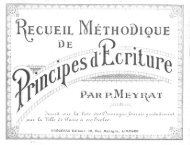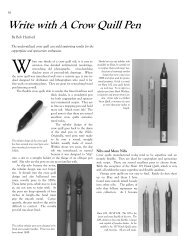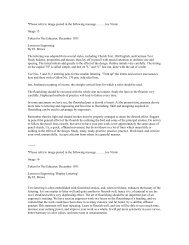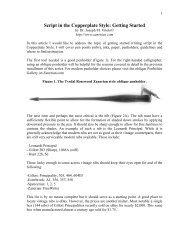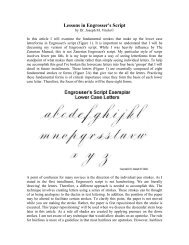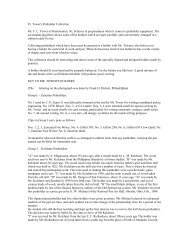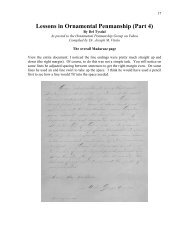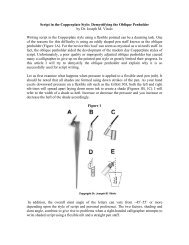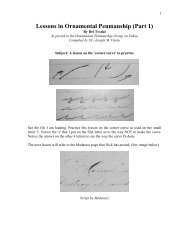The Educator (Volume 45) - IAMPETH
The Educator (Volume 45) - IAMPETH
The Educator (Volume 45) - IAMPETH
Create successful ePaper yourself
Turn your PDF publications into a flip-book with our unique Google optimized e-Paper software.
BOOK REVIEWS<br />
Our readers are interested in books of merit,<br />
but especially in books of interest and value to<br />
commercial teachers includingr books of special<br />
educational value and books on business subjects.<br />
All such books will be briefly reviewed<br />
in these columns, the object being: to givt suffi-<br />
cient description of each to enable our readers<br />
to determine its value.<br />
Economic Geography, Third Edition,<br />
by Z. Carleton Staples, Master,<br />
Dorchester High School for Boys,<br />
Boston, Massachusetts, and G. Morell<br />
York, Professor of Commerce, New-<br />
York State College for Teachers, Albany,<br />
New York. Published by the<br />
South-Western Publishing Company,<br />
Cincinnati, Ohio. Cloth cover, 702<br />
pages.<br />
ECONOMIC GEOGRAPHY. Third Edition.<br />
is a complete revision of a previous edition<br />
now widely used. In revising- the textbook<br />
the authors have retained those features of<br />
the previous edition which were popular with<br />
students and teachers. New subject matter<br />
has been added. All discussions and data<br />
have been brought up to date, and all topics<br />
have been carefully checked for accuracy and<br />
teachability.<br />
APPROACH. You may approach the subject<br />
from three distinct points of view, because<br />
the book is divided into three parts<br />
Part I. Man and His Environment: Part 11.<br />
Products of Commerce and Industry ; and<br />
Part III. Regions of Commerce. You may<br />
teach the parts in the sequence in which they<br />
are prt-sented or in any other sequence or<br />
combination that you prefer.<br />
ORGANIZATION. <strong>The</strong> textbook is not only<br />
divided into three parts, but most chapters<br />
are also divided into sections. For example.<br />
Chapter I is divided into two sections, each<br />
of which is suitable for an assignment.<br />
PERMANENT VALUE. Wars cause political<br />
boundaries to change and therefore<br />
textbooks based entirely on political boundaries<br />
are likely to go out of date rapidly.<br />
However, economic and racial areas do not<br />
change very rapidly. In order to give ECO-<br />
NOMIC GEOGRAPHY a degree of sUbility<br />
and permanence, the authors have been very<br />
careful in the treatment of political boundaries.<br />
In those parts of the world where<br />
boundaries are likely to shift, the regions are<br />
presented by natural economic and racial<br />
areas, such as "Central Europe," "Mediterranean<br />
Countries.*' and "Scandinavian Coun-<br />
NEW TOPICS. Many new discussions have<br />
been added in order to give the student information<br />
about the latest developments and<br />
influences. Those topics include radio, aviation,<br />
power dams, weather bureaus, and soil<br />
erosion. An important new section on conservation<br />
has been introduced.<br />
ILLUSTRATIONS. <strong>The</strong> book contains almost<br />
300 illustrations, including pictures,<br />
charts and maps. Many of the pictures are<br />
shown in colors. <strong>The</strong> pictures are large<br />
enough so that they are understandable. Every<br />
illustration serves a definite purpose in enriching<br />
the di;<br />
MAPS. Many new maps have been added.<br />
<strong>The</strong> maps are clearer and larger than in the<br />
older edition. Several of the maps are<br />
printed in colors.<br />
PICTORIAL CHARTS. Many pictorial<br />
charts have been introduced to make the<br />
presentation more interesting and fascinating.<br />
DATA TABLES. All the data in the book<br />
and in the appendix have been brought up to<br />
date according to the latest figures.<br />
VOCABULARY AND STYLE. <strong>The</strong> book<br />
has been very carefully written so that it has<br />
a semifiction style that grasps the attention<br />
of the student. <strong>The</strong> terminology has been<br />
kept within the reading ability of high school<br />
students. <strong>The</strong> student's interest ia maintained<br />
because of the emphasis on reasons and principlee<br />
rather than on statistics and abstract<br />
facts.<br />
:<br />
<strong>The</strong> <strong>Educator</strong> 29<br />
Success Through Salesmanship, by<br />
J, Murray Hill, First Vice President,<br />
Bowling Green Business University,<br />
Bowling Green, Kentucky, and R. G.<br />
Walters, Personnel Officer, Grove City<br />
College, Grove City, Pennsylvania.<br />
Published by the South-Western Publishing<br />
Company, Cincinnati, Ohio.<br />
Cloth cover, 436 pages.<br />
SUCCESS THROUGH SALESMANSHIP<br />
has been prepared especially for private<br />
schools and colleges. It may be used either<br />
with students who have had no previous<br />
training in salesmanship or with students<br />
who have had courses in salesmanship in<br />
high school.<br />
STUDENTS WHO ARE PREPARING FOR<br />
SALES WORK NEED SALESMANSHIP.<br />
Some students who use this textbook may<br />
enter sales work immediately after graduation<br />
from college. Others may spend a preliminary<br />
period in an office, and enter sales<br />
work later. <strong>The</strong> material is so practical that<br />
it will be helpful in either case.<br />
STUDENTS WHO ARE PREPARING FOR<br />
OFFICE WORK NEED SALESMANSHIP.<br />
<strong>The</strong> subject of salesmanship has great value<br />
not only to those who may become salespeople,<br />
but also to prospective office workers.<br />
All office workers must use the principles of<br />
salesmanship in applying for positions and<br />
in winning promotion after they are employed.<br />
<strong>The</strong>y likewise use the principles of<br />
salesmanship in their contacts with outsiders<br />
who may visit their offices or with whom<br />
thev come in contact by teleohone or letter.<br />
SALESMANSHIP APPLIED TO OFFICE<br />
WORK. Since the book is intended for prospective<br />
office workers as well as for prospective<br />
salespeople, all the principles discussed<br />
have been made to apply to the work of bookkeepers,<br />
stenographers, and other office employees.<br />
DEVELOPING A GOOD PERSONALITY.<br />
Success in any work depends largely upon<br />
the possession of a good personality. Two<br />
full units are devoted to the development of<br />
personality.<br />
SALESMANSHIP APPLIED TO LETTER<br />
WRITING. A full unit is devoted to the application<br />
of the principles of sales letters.<br />
This is a uniaue feature of the book.<br />
SALESMANSHIP APPLIED TO ADVER-<br />
TISING. A full unit is also devoted to the<br />
application of the principles of salesmanship<br />
to advertising, which is merely salesmanship<br />
in printed form. This likewise is a unique<br />
feature of the textbook.<br />
SAT-FSMANSHIP APPLIED TO GETTING<br />
A POSITION. Regardless of how skilled they<br />
may be in their own occupations, bookkeepers<br />
and stenographers frenuently have difficulty<br />
in getting positions. <strong>The</strong>y do not know how<br />
to sell themselves. Unit 24 shows the studen<br />
how to apply the principles of selling to<br />
getting a job. This unit is especially valuable<br />
to voung graduates.<br />
QUESTIONS ON THE TEXTBOOK. Textbook<br />
questions are used to determine whether<br />
the students undersUnd what they have read.<br />
PROBLEMS FOR DISCUSSION. <strong>The</strong> discussion<br />
problems force the student to apnly<br />
the principles of salesmanship to specific<br />
PROJECTS. Projects accompany every<br />
unit. <strong>The</strong>y renuire orieinal work on the part<br />
of students and are intended to develop skill<br />
in the various ohases of selling.<br />
ILLUSTRATIONS. Numerous pictures illustrate<br />
the principles applied to sales situations.<br />
In addition, many illustrations show<br />
the application of the principles of salesmanship<br />
to the work of bookkeepers, stenograph-^rs.<br />
and other emnlnvees.<br />
TEACHERS' MANUAL. <strong>The</strong> teachers'<br />
manual provides helpful teaching suggestions<br />
and solutions to the three types of problems<br />
and projects. It is furnished free to each<br />
teacher who uses the textbook for classroom<br />
instruction.<br />
Applied Business Arithmetic, by<br />
Preston E. Curry and Ralph R. Rice,<br />
University High School. Oakland,<br />
Calif. Published by the South-Western<br />
Publishing Comnany, Cincinnati,<br />
Ohio. Cloth cover, 576 pages.<br />
APPLIED BUSINESS ARITHMETIC is a<br />
striking new revision of a previous edition<br />
that was published under the title of BUSI-<br />
NESS ARITHMETIC. Part I is devoted to<br />
those business calculations that are of particular<br />
interest to the individual but that<br />
are also necessary in a business occupation.<br />
Part II is devoted to the calculations that are<br />
especially required of employees in business.<br />
ORGANIZATION. This textbook is divided<br />
into two distinct parts: Part I. BUSINESS<br />
ARITHMETIC FOR PERSONAL USE; and<br />
Part II, ARITHMETIC FOR BUSINESS<br />
USE. Each part is divided into units, and<br />
the units are subdivided into sections. Each<br />
unit is devoted to a group of related types<br />
of calculations.<br />
FUNCTIONAL PRESENTATION OF FUN-<br />
DAMENTALS. <strong>The</strong> authors have carefully<br />
avoided the abstract presentation of the fundamentals<br />
of addition, subtraction, multiplication,<br />
and other processes. Addition is introduced<br />
in the first lesson. It is made practical<br />
but simple by basing it on deposit<br />
tickets. <strong>The</strong> next lesson involves addition<br />
and subtraction based on check stubs. <strong>The</strong><br />
functional presentation in Units 1. 2, and 3<br />
covers all the fundamental operations.<br />
TEACHING PLAN. Careful attention has<br />
been given to the organization of definite<br />
steps in the teaching procedure. This teachng<br />
pro edur<br />
interesting discussion<br />
(2) Practical problems<br />
(3) Drills for accuracy and speed<br />
(4) Optional problems<br />
<strong>The</strong> following types of problems occur at the<br />
end of each unit:<br />
(5) Questions for class discussion, covering<br />
the entire unit<br />
(6) Oral review problems, covering the entire<br />
unit<br />
(7) Review problems, covering the entire<br />
unit<br />
(S) Projects, covering the entire unit<br />
VARIETY AND SUPPLY OF PROBLEMS.<br />
A study of the teaching plan will disclose the<br />
procedure for developing a thorough mastery.<br />
Adequate provision has been made to take<br />
care of students with varying abilities and to<br />
provide materials for various classroom administrative<br />
plans. <strong>The</strong>re are plenty of problems<br />
with each unit.<br />
ILLUSTRATIONS. APPLIED BUSINESS<br />
ARITHMETIC is profusely illustrated with<br />
several types of illustrations as follows:<br />
(1) Business forms as a basis of discussion<br />
(2) Pictorial diagrams<br />
(3) Pictures<br />
(4) Graphs, charts, and maps<br />
(5) Tables<br />
CORRELATION WITH OTHER SUBJECTS.<br />
APPLIED BUSINESS ARITHMETIC correlates<br />
closely with other commercial subjects.<br />
<strong>The</strong> following are a few specific ways in<br />
which this correlation is obtained:<br />
(1) Bookkeeping<br />
(2) Selling<br />
(3 \ Office practice<br />
(4) General business<br />
(6) Commercial law<br />
Introductory Economics (Second<br />
Edition) , by James Harvey Dodd,<br />
Ph.D., Professor of Commercial Education<br />
and Head of the Department of<br />
Commerce, Mary Washington College,<br />
Fredericksburg, Virginia. Published<br />
by the South-Western Publishing<br />
Company, Cincinnati, Ohio. Cloth<br />
cover, 596 pages.<br />
INTRODUCTORY ECONOMICS. Second<br />
Edition, is a thorough and an up-to-date revision<br />
of a textbook that has been exceptionally<br />
popular because of its clear, simple, and<br />
lucid manner in presenting economic principles<br />
in terms of the everyday life of the<br />
individual. Many new improvements and<br />
many new topics have been added in this<br />
APPROACH. A carefully selected approach<br />
has been used in this revision in order that<br />
the subject matter content will have an immediate<br />
appeal to the imagination and the<br />
interest of the student without confusing<br />
him wih technical theories. For instance.<br />
Part I, which includes the first three chapters,<br />
provides a natural background or setting<br />
for the presentation of the various economic<br />
problems that are to follow.<br />
ORGANIZATION. <strong>The</strong> subject matter is<br />
organized in such a manner that new knowledge<br />
is built upon old knowledge. In other<br />
words, the student proceeds from the known<br />
to the unknown. This plan is not only developed<br />
throughout the entire book, but it ia<br />
also followed as a definite plant within each<br />
chapter. Appropriate subject matter is carefully<br />
grouped in each part and each part<br />
logically follows the preceding topics.



